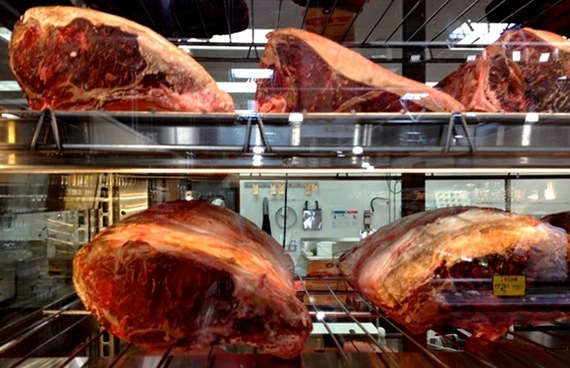Overcook a chicken breast or pork chop, and you'll face few consequences. Overcook a prime rib, and your reputation as a grill master will combust faster than the Yule log.
Prime rib is the ultimate main course for a holiday dinner or New Year's Eve feast, not to mention the most majestic—and possibly expensive—piece of meat you will ever cook. Expensive? A 10-pound roast serving 8 to 10 adults could set you back over $200 at your local supermarket, or over $800 if you opt to serve Wagyu beef from a pricey Yup-scale online purveyor. (Not including shipping.)
Nevertheless, when it comes to an eye-popping, show-stopping, unrepentantly carnivorous centerpiece, nothing, I repeat nothing beats prime rib. It firmly establishes you as the master griller and gracious host that you are.
Even the most decorated grill masters feel a twinge of fear when put in charge of grilling a prime rib. That's why I'm sharing my seven secrets for transforming this luxurious cut of meat into a smoke-blasted, garlic-, pepper-, and herb-slathered prime rib that will leave everyone speechless.
- Know your anatomy: A full prime rib—sometimes referred to as a standing rib roast—is comprised of the sixth through the twelfth ribs (seven bones): It is located between the chuck and short loin sections and on top of the plate, primal cuts all. Like beef tenderloin, the "eye" of the muscle receives little exercise, making it fine-textured and exceedingly tender.
How much is enough? Butchers use two rules of thumb. When buying a large prime rib, figure on one pound per person. A one-bone roast will feed two hungry adults (or three as part of a large meal). A 4-bone prime rib (which is a large but manageable size for most grills) will feed eight to ten people. Unfortunately, this puts you in a King Solomon-esque dilemma, for while everyone will receive great meat, only half the people will get rib bones. A truly wise person might roast an extra rack of beef ribs so everyone gets a bone. Just sayin'. Bondage and dominance: Prime rib has naturally occurring lines of fat that divide the "eye" of the muscle from the spinalis dorsi, commonly known as the cap. Tying the roast with butcher's string between the bones (bone-in roast) or at 1-1/2 inch intervals (boneless roast) will discourage separation along these natural fault lines as the meat cooks. It will not only be easier to carve, but will make for a more professional-looking presentation on the plate. The French cut: It's entirely optional, but in the interest of aesthetics, you can "french" the rib bones or ask your butcher to do it. This is a fancy term for scraping the exposed part of the ribs clean of meat, fat, and cartilage before roasting. (Theoretically, this enables you raise a bone to your mouth without soiling your fingers.) Lay the prime rib on a cutting board meat side up. Using a sharp knife, cut through the fat cap straight down to the rack of bones, then come in through the side from the end, your knife parallel to the bones, until you intersect your first cut. Remove the resulting fatty wedge. Next, cut out the pieces of meat between the ends of the ribs. (Roast these alongside the prime rib so you'll have drippings for Yorkshire pudding.) Using a small sharp paring knife, thoroughly scrape the bones clean. Finally, trim the remaining fat cap to a depth of 1/2 inch. Up in smoke: There are many ways to cook a prime rib: indirect grilling, spit-roasting, in a smoker, etc ... However you do it, a blast of hardwood smoke can turn an excellent prime rib to the stuff of legends. I'm partial to the clean flavor of oak, but hickory and cherry are good options, too. (Mesquite is a little strong.) Soak the chips for 30 minutes in water to cover, then drain before tossing them on the coals, or placing them in your grill's smoker box. Is it done yet? If you don't own one, I strongly recommend you invest in a reliable instant-read meat thermometer before you shop for the prime rib. A remote thermometer is another option. In either case, know exactly what your target temperature is before lighting your grill or smoker. The internal temperature in the deepest part of the meat should be 120 to 125 degrees for rare and 130 to 135 for medium-rare (remember, the roast will continue to cook as it sits). Any higher, and the meat fibers rapidly begin to shrink and dry out. If some guests at your table requests prime rib medium-well or well-done, serve them an end cut or sear their portions directly over the fire on your grill or in a hot frying pan. Give it a rest: One of the most important steps in nailing the perfect prime rib is to give it time to rest after you remove it from the grill and before serving. Heat drives juices toward the center of the meat, and a rest gives them the chance to redistribute themselves. In the case of prime rib, loosely tent with foil and let rest for 15 to 30 minutes before carving. This gives you time to make the Yorkshire pudding. I hope this prime rib makes your holiday dinner even more celebratory. As always, post your photos and bragging rights on our Barbecue Board.
Get more tips on buying, prepping prime rib on my Barbecue Bible blog.
Do you need prime rib recipe ideas? Try these two holiday favorites:
READ THESE BOOKS BY STEVEN RAICHLEN:
READ MORE ABOUT GRILLING AT BARBECUEBIBLE.COM: Steven Raichlen is the author of the Barbecue! Bible cookbook series and the host of Primal Grill on PBS. His web site is www.barbecuebible.com.
